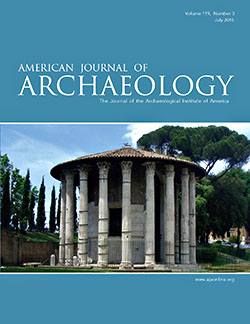AJA Open Access
BY-NCJuly 2015 (119.3)
Book Review
Corpus vasorum antiquorum. Germany 95. Berlin 15: Attisch rotfigurige und schwarzgefirnisste Peliken, Loutrophoren und Lebetes Gamikoi
By Angelika Schöne-Denkinger
Reviewed by Thomas Mannack
Corpus vasorum antiquorum is the oldest project of the Union Académique Internationale (UAI). It was conceived by Edmond Pottier at the Louvre and intended to publish all ancient pottery in public and private collections worldwide. The first fascicle was published in 1922. As in all the early volumes, vases were supplied with the briefest of descriptions, state of preservation, measurements, date, bibliography, and small black-and-white photographs. With time it was recognized that the initial aim of including all ancient ceramics was too ambitious, and CVA now concentrates on Greek and related figure-decorated wares.
The standards of cataloguing vases has evolved steadily, and the volume reviewed here, the 95th in the German series and the 15th dedicated to the Antikensammlung in Berlin, meets the latest and exacting requirements of the UAI. Schöne-Denkinger presents 30 red-figure and 4 black-painted pelikai, 9 loutrophoroi, and 8 lebetes gamikoi. An appendix is dedicated to five pelikai once in Berlin and now housed in other museums as well as vases lost in the war. Most of these are illustrated in black-and-white on five Beilagen. Each shape is introduced with a highly knowledgeable and comprehensive description of the origin of its name, history, use, distribution, and iconography. The vases are illustrated with large photographs, including pictures of details, on 80 color plates, now standard for the German series, and 41 profile drawings on 11 Beilagen. Black-and-white photographs and line drawings in the main body of the text complete the presentation. The text provides the inventory number, the find place where known, previous collections, detailed measurements of the containers, including weight and volume, the height of the figures, a complete bibliography, a brief history of conservation and restoration, descriptions of ornaments and figural scenes, and a detailed scholarly discussion of the vase and its art historical and iconographical context. Almost all the vessels are complete, and most, save for the pelike 1962.1 and the lebes fragments 31573 V.177 illustrated here for the first time, have been previously published.
The quality of the Berlin collection assures that some “important” painters of pelikai are well represented—for example, the Kleophrades (F 2170) and Pan (1962.62, 4283) Painters, the Earlier Mannerists (F 2172, 3223), the Achilles (F 2355) and Phiale (F 2358) Painters, and the Washing Painter (F 2364). Surprisingly few of the loutrophoroi and lebetes have been assigned to an artist; among these are artists working in the manner of the Meidias (F 2373) and Talos (3209) Painters and the Sabouroff Painter (F 2404). Epiktetos II, named after a signature added in the 19th century and removed by Sir John Boardman, still finds his way into publications. The section on the pelike F 2170 recounts the history of the inscription, which is illustrated with a black-and-white photograph in the text.
Many of the scenes are particularly interesting. The pelike 3154 juxtaposes Herakles, unusually draped in chiton and himation in addition to his lion skin, in conversation with a man of uncertain identity, with a Theseus adventure. The scene on the vase F 2173, a woman filling a hydria at a fountain house on the obverse, and a satyr using the same fountain house to fill a pointed amphora on the reverse, still awaits a definitive interpretation. A bird-man on the pelike fragment 4283 has been seen as a demon or a comic actor. An early form of tragedy may be depicted on the pelike 3223, with a pipes player and a maenad with sword and torn animal. On the pelike 3189, Apollo attacks Tityos with bow and sword, a combination of weapons usually associated with depictions of Persians. The publication of the pelike F 2357, decorated with a “Parthenonian horseman” in high-quality color, is also most welcome.
Among the larger vases published here, the well-known wedding loutrophoros F 2372, the battle loutrophoros 3209, combining the departure of a young knight on the body with an Amazonomachy in the frieze below, and the well-preserved lebetes F 2404 and F 2405 are particularly noteworthy.
In short, this volume is an outstanding example of the strengths of the CVA project. The exhaustive and flawless information given by an acknowledged expert of Greek vase painting and the superb illustrations will enable historians, art historians, archaeologists, and students of religion to see these vases in a new light.
Thomas Mannack
Beazley Archive
Oxford University
